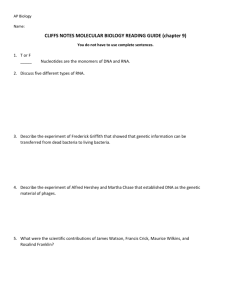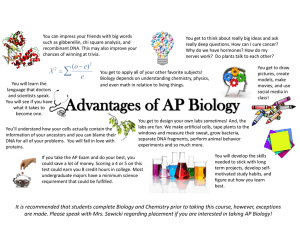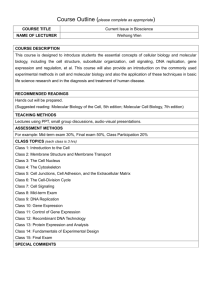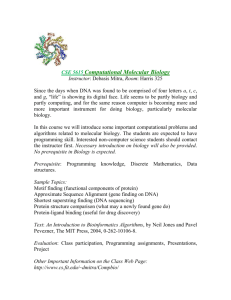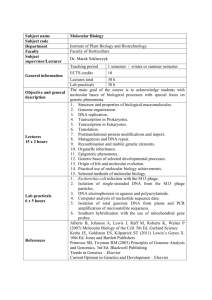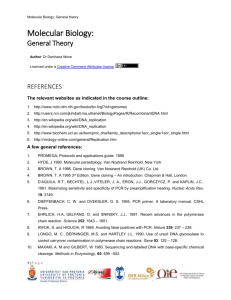Physics 176/276 Quantitative Molecular Biology Instructor: Massimo Vergassola Winter 2014
advertisement
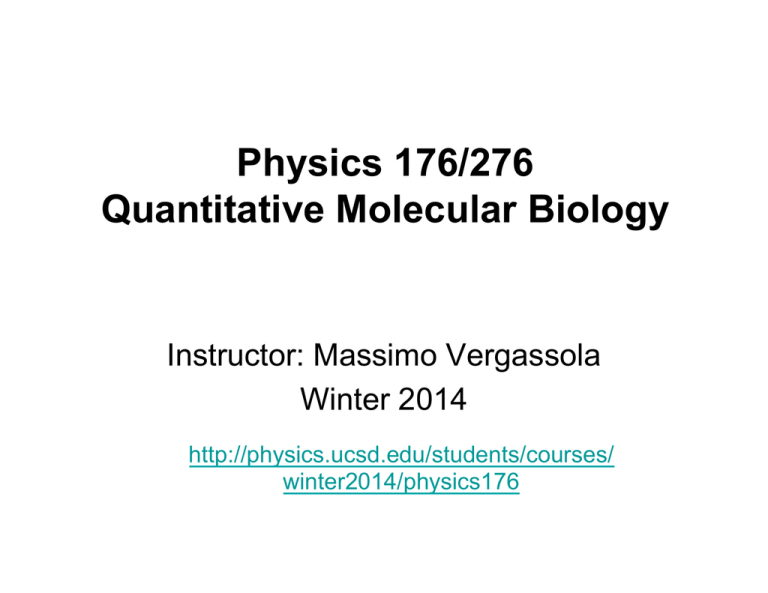
Physics 176/276 Quantitative Molecular Biology Instructor: Massimo Vergassola Winter 2014 http://physics.ucsd.edu/students/courses/ winter2014/physics176 Historical perspective 18-19th-century: industrial revolution controlled conversion -- steam boats, railways, assembly line of chemical energy for -- chemical, electrical, steel industries useful mechanical work -- automobiles, tanks, airplanes, … è key technology: steam engine, piston, turbine & reaction engines è scientific foundation: thermodynamics, physical chemistry 20th-century: information revolution -- transistors, integrated circuits, microprocessors designed manipulation of electronic flow -- calculators, personal computers, internet for info processing -- wireless, nano, smart materials, … è key technology: integrated circuits manufacturing & material processing è scientific foundation: quantum mechanics, information theory 21st-century: bio revolution designed manipulation or informed -- biofuel, bioremediation intervention of biological organisms -- rational drug design for useful purposes = synthetic biology -- personalized medicine è key technology: DNA sequencing/synthesis, ‘omics ? è scientific foundation: quantitative & systems biology ??? Historical perspective on theory/applications Savery engine ≈ 1700 Newcomen engine ≈1710 James Watt ≈1765 Steam engines (inefficient) were built on a practical basis well before theoretical understanding. Sadi Carnot ≈1824 In Carnot’s paper you can count equations on the fingers of your hands Historical perspective on theory/applications Morse ≈1840 Telegraph lines ≈1891 Why quantitative biology? -- because biology is quantitative -- needed to formulate falsifiable predictions -- demanded by synthetic biology What is quantitative biology? è quantitative biology ≠ biology-inspired physics ≠ application of pre-existing methods to bio problems Use numbers to gain quantitative and qualitative understanding Role of theory • link across different scales, i.e., from components to systems • formulate expectations and predictions (via quantitative models) • guide the design of new experiments, e.g. more discriminatory, and technology, e.g. more effective. • power: the generality of (falsifiable) ideas and principles • “cost”: basic principles usually streamline, simplify the guess-and-try process of technological progress. New concepts and principles lead to new perspectives "Heavier than air flying machines are impossible." -- Lord Kelvin "Flight by machines heavier than air is impractical and insignificant, if not utterly impossible." -- Simon Newcomb, Director, U.S. Naval Observatory, 1902 "Aerial flight is one of that class of problems with which man will never be able to cope." -- Simon Newcomb, 1903 "The popular mind often pictures gigantic flying machines speeding across the Atlantic carrying innumerable passengers in a way analogous to our modern steam ships. . . it seems safe to say that such ideas are wholly visionary and even if the machine could get across with one or two passengers the expense would be prohibitive to any but the capitalist who could use his own yacht." -- William Henry Pickering, Astronomer, 1910 A few successful paradigmatic examples -- Mendel’s laws of genetics -- Luria-Delbrück experiment and fluctuation test -- Hopfield’s theory of kinetic proof-reading -- Ho-Perelson’s model of HIV kinetics Mendel’s laws of genetics First law of Segregation Mendel’s conclusions • • • • • Hereditary determinants are of a particulate nature (genes). Each parent has a gene pair for each trait. One member of the gene pair segregates into a gamete, i.e. each gamete carries one member of the gene pair. Gametes unite at random, irrespective of the other gene pairs involved. For the examples here, one of the two types (alleles) is dominant. Second law Independent Assortment Phenotype 9 Yellow, Round Seed 3 Yellow, Wrinkled Seed 3 Green, Round Seed 1 Green, Wrinkled Seed Genotype G_W_ G_ww ggW_ ggww Remarkable features • Quantitative experiments (engineered pure lines and used statistics) and did not just describe what he saw: physicists do not have the monopole…. • Strong abstraction (laws synthesizing data and predicting results of new experiments, e.g. backcrossing or co-dominant traits) with new concepts (gene) going even beyond the existing limits (it will not be clear what a gene is for more than a century….). • Created the new field of genetics (even though it took some time to rediscover…). • A bit of luck helps….. Not all traits are Mendelian and segregate independently. Microbiologist î Theoretical í physicist Are mutations random or induced by natural selection? (Bacterio)Phages are viruses of bacteria A small fraction of E. coli bacteria in a colony are resistant to infection by phages. Use the phage-bacteria system for an experiment to discriminate between the two hypotheses: random vs induced mutations ? Poisson statistics The experiment invalidates the hypothesis of directed mutations Kinetic proofreading (Hopfield, PNAS, 1974; Ninio, Biochimie, 1975) How can differences in affinity of ligands be amplified? Equilibrium Non-equilibrium: energy expended in the phosphorylation steps If reactions strongly biased towards dissociation, i.e. they circulate many times before product, then specificity squared Proofreading costs energy! Proofreading processes are crucial for the cellular dynamics Replication: DNA polymerase adds incorrect nucleotides with a rate ≈10-5 which is reduced by proofreading processes to the observed error rate≈10-9. Translation: the fidelity of aminoacids in proteins is improved by proofreading with respect to the bare accuracy ensured by tRNAs Immune discrimination: first self-non self discrimination by T-cells involves a proofreading cascade (McKeithan PNAS 1995; Altan-Bonnet & Germain, PLoS Comp. Biol. 2005; Francois et al, PNAS 2013) MD with BS in physics theoretical physicist AIDS: a disease with long latency (~10 years) [Ho et al, Nature 1995] RNA copies per ml (x 103) Production-clearance balance perturbed by ABT-538 administered to patients; kinetics assayed (response function of a dynamical system!). T1/2 = 3.3 days days About 109 virions/day get cleared and a similar amount of lymphocytes produced! è rapid viral clearance by the immune system: long latency due to balance of fast viral production & clearance è intervention strategy: treat early with multiple drugs Estimates of the clearance rate c of virions and the lifetime δ of infected cells Three key elements of quantitative biology wet-bench biology qBio quantitative experimentation theoretical abstraction è Collaboration of labs with different expertise è New generation of researchers combining multiple expertise è This course: quantitative molecular biology of bacteria Historical perspective 19th-century: industrial revolution controlled conversion -- steam boats, railways, assembly line -- the state of bacterial cells strongly depends on environmental of chemical energy for -- chemical, electrical, steel industries conditions and on a huge number useful mechanical work -- automobiles, tanks, airplanes, … of parameters key can technology: --èhow it eversteam work?engine & steel large number è scientific foundation: thermodynamics, physical chemistry -- how can it be “understood”? 20th-century: information revolution -- transistors, integrated circuits, microprocessors designed manipulation of electronic flow -- calculators, personal computers, internet “Now in the further development more than forwant info processing -- wireless, nano, smart materials, …of science, we è key technology: integrated circuits manufacturing then & material processing just a formula. First we have an observation, we scale have small è scientific foundation: quantum mechanics, information theory numbers that we measure, then we have a law which 21st-century: bio revolution summarizes all the numbers. But the real glory of science is that designed manipulation or informed -- biofuel, bioremediation intervention of biological organisms rational design we --can find drug a way of thinking such that the law is evident.” strong heterogeneity for useful purposes = synthetic biology -- personalized medicine è key technology: DNA sequencing/synthesis, ‘omics, adv imaging, ??? è scientific foundation:from quantitative & systems biology,on ???Physics The Feynman Lectures Systems biology 1. Scope and focus: ➢ ➢ ➢ biological systems whose functions are derived from the interaction of many sub-components ex: from macromolecluar assemblies to ecological communities current focus: subcellular and cellular processes, e.g., genetic circuits, protein interaction networks [Davidson et al, 2002] ➢ long-term goals: – mapping out the complete wiring diagram of the cell – quantitative, predictive computational model of the cell 2. Circuit diagram as system-level descriptor ? circuit diagram supplemented by component parameters provides a concise quantitative description of the system electronic circuits simple & well characterized; circuit topology not necessarily predictive of system function; need to know the properties of the nodes genetic circuits components many (~109); fast (10-9 sec) heterogeneous, most rates unknown; few (~1000); slow ( >10 min) physical interconnect between connectivity well-insulated components (1~2 inputs per node) multiply-connected (1~10 inputs per node); regulation at all stages network complexity combinatorial signal integration from complex molecular control iterated cascades from complex network wiring Experimental & Computational Approaches traditional mol bio: one gene, one process (e.g., A activates B) high throughput methods bioinformatic analysis • quantitative expts and modeling • design and synthesis of biomolecluar systems one/few genes, multiple processes (e.g., txn init/term, post-tsl modification, degradation, small genetic circuits) many genes, one/few process(es) (e.g., genome-wide survey of gene exp) qualitative circuit diagram linking many nodes quantitative model of individual nodes many components, many processes (e.g., predictive modeling of the cell) Scope of this course • focus on simple systems (mostly bacteria) • role of theory, modeling, and computation • multiple aspects (e.g., tsx initiation, post-tsx control, degradation) • emphasize quantitative connections between molecular and physiological (functional) aspects ❖ course content – review of molecular microbiology – molecular interactions: ligand-protein, protein-DNA and protein-protein – transcriptional initiation control: activation, repression, and combo – post-transcriptional control: attenuation, termination, degradation – modeling genetic circuits: bistability and oscillation – stochastic gene expression and phenotype – growth physiology and control – bacterial motility Overview of molecular microbiology Plan 1. 2. 3. 4. 5. 6. biochemical aspects mechanistic aspects regulatory aspects genomic aspects physical aspects comparison to eukaryotes life of a bacterium: matter + energy è biomass • chemical composition of biomass: CH1.80O0.43N0.143 (+ S, P, Mg, Fe, …) • molecular composition: [total weight: 10-12 g per cell; 70% water] energy cost of biosynthesis: [minimal medium: ~ 560 J/g dry weight] molecular species %dry weight energy cost (J/g) protein 55 220 RNA 20 200 DNA 3 30 small molecules 3 10 lipid membrane 9 80 cell wall 10 20 NB: latent heat of melting H2O: 334 J/g; cost for proteins is several fold the cost for the peptide bonds holding together the protein: proofreading ❖ metabolism • sequester & breakdown nutrients – derive energy – generate carbon precursors – sequester N, S, P, metals glucose (6C) 4x ATP+2x NADH glycolysis • biosynthesis – – – – amino acid nucleic acid lipids co-enzymes isozymes IlvBN, IlvGM, IlvIH CO2 2x pyruvate H+, NADPH IlvC NADP+ 2x pyruvate (3C) fermentation respiration 8x ATP NH3 32x ATP 6x CO2 (need O2) 2x acetate + 2x CO2 è Pasteur and Crabtree effects (Sussman et al., 1979) Glu H2O aKG valine IlvE IlvD ❖ metabolism • typical biochemical reaction: S + Cb ⇄ Sb + C S: substrate b: component (e.g., CH3, NH2, e-) C: co-enzyme (needed for difficult reactions) è most reactions catalyzed by enzymes (proteins) è flux of the products and “byproducts” need to be balanced metabolic control via coordinated regulation of enzyme abundance/ activity Many enzymes and products are common to different pathways, which branch out of one another. That produces the structure of the graph above. It also leads to interference effects such as growth inhibition. It is very common that growth is inhibited when one amino acid is added to a minimal medium. Growth is often rescued by adding a (specific) second one. feedback inhibition threonine NH3 • 1st reaction of pathway often inhibited by product • same enzymes used for synthesis of leucine, isoleucine • Isozymes: enzymes catalyzing the same reaction but with slightly different properties, e.g. affinities, cofactors, etc • in E. coli K-12, ilvG is defective è valine sensitivity in minimal media è α-ketobutyrate toxicity (repressed by isoleucine) IlvA α-ketobutyrate IlvC IlvGM pyruvate IlvD IlvE CO2 H2O IlvIH IlvBN IlvC IlvD isoleucine IlvE CO2 H2O pyruvate valine Overview of molecular microbiology Plan 1. 2. 3. 4. 5. 6. biochemical aspects mechanistic aspects regulatory aspects genomic aspects physical aspects comparison to eukaryotes ❖ Central Dogma amino acids, NTP, dNTP, lipids, … rRNA rpl tsx DNA tRNA ribosomes tsl ribosomal proteins structural proteins mRNA transporters sRNA regulators tmRNA; CRISPR RNAs, etc. sugar, NH3, O2 enzymes RNAp DNAp ❖ DNA replication • the four “bases” of DNA: pyrimidines (C, T) and purines (A, G) • DNA synthesis • the replication fork • initiation of DNA replication – doubling time of E. coli can vary over 10x [ fastest doubling time: ~20 min] – 40 min required to replicate chromosome – fixed time of 20 min between completion of one round of replication and cell division è doubling time > 60 min: waiting time between division & replication è doubling time < 60 min: multiple replication forks è one replication origin every 1.7 µm (length of unit cell): fast growing cells are larger! Questions: - how does the cell “measure” and controls its size? - Position on the chromosome of genes and its relation to expression levels? ❖ transcription: DNA to RNA • RNA tRNA DNA vs RNA: • RNA synthesis: heavily transcribed genes coding ribosomal RNA transcriptional initiation elongation and termination ❖ translation: mRNA to protein ❖ translation: tmRNAs tmRNAs are a structural hybrid of tRNA and mRNA In trans-translation, tmRNA binds to bacterial ribosomes which have stalled, it recycles them and adds a proteolysisinducing tag to the unfinished polypeptide, which gets degraded.

